ISElective1_CM9
1/38
Earn XP
Description and Tags
ISElective1_CM9
Name | Mastery | Learn | Test | Matching | Spaced |
|---|
No study sessions yet.
39 Terms
the process of making sure that the users’ views and expectations of the new product are realistic.
Expectation management
Users who are involved and feel that they have contributed to a product's development, are more likely to feel a sense of "ownership" towards it and to be receptive to it when it finally emerges.
OWNERSHIP


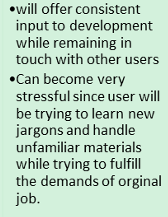

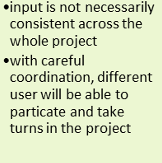



means that the real users and their goals, not just technology, should be the driving force behind development of a product. As a consequence, a well designed system should make the most of human skill and judgment, should be directly relevant to the work in hand, and should support rather than constrain the user.
User-centered approach






In a user-centered approach to design, while technology will inform design options and choices, it should not be the driving force. Instead of saying, "Where can we deploy this new technology?", it must be "What technologies are available to provide better support for users' goals?"
EARLY FOCUS ON USERS AND TASKS: User's tasks and goals are the driving force behind the development.
This is about more than just capturing the tasks and the users' goals. How people perform their tasks is also significant. Understanding behavior highlights priorities, preferences, and implicit intentions.
EARLY FOCUS ON USERS AND TASKS: Users' behavior and context of use are studied and the system is designed to support them.
When things go wrong with technology, we often say that it is our fault. But as humans, we are prone to making errors and we have certain limitations, both cognitive and physical. Products designed to support humans should take these limitations into account and should limit the mistakes we make.
EARLY FOCUS ON USERS AND TASKS: Users' characteristics are captured and designed for.m.
There are different levels of user involvement and there are different ways in which to consult users. However, involvement is organized, it is important that users are respected by designers.
EARLY FOCUS ON USERS AND TASKS: Users are consulted throughout development from earliest phases to the latest and their input is seriously taken into account.
This does not necessarily mean that users are actively involved in design decisions. As long as designers remain aware of the users while making their decisions, then this principle will be upheld.
EARLY FOCUS ON USERS AND TASKS: All design decisions are taken within the context of the users, their work, and their environment.
method that comes originally from anthropology and literally means "writing the culture". It has been used in the social sciences to display the social organization of activities, and hence to understand work. It aims to find the order within an activity rather than impose any framework of interpretation on it. It is a broad-based approach in which users are observed as they go about their normal activities.
Ethnography
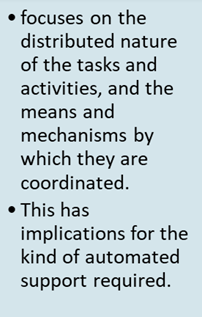
main dimensions

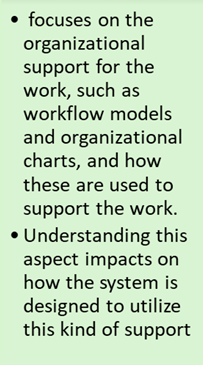
main dimensions

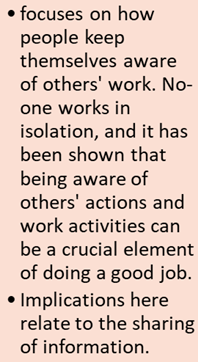
main dimensions

method combines experiences of using ethnography to inform design with developments in requirements engineering.
Coherence
set of focus questions for each of the three dimensions intended to guide the observer to particular aspects of the workplace. They can be used as a starting point to which other questions may be added as experience in the domain and the method increases.
Viewpoints
a kind of goal, and they represent criteria that guide the requirements activity.
Concerns
Concerns: These are embodiments of plans and procedures, and at the same time are a mechanism for developing and sharing an awareness of work.
Paperwork and computer work.
Concerns: This refers to the "workarounds" that are developed in organizations and are at the heart of how the real work gets done.
Skill and the use of local knowledge.
Concerns: looks at the physical layout of the workplace and areas where time is important.
Spatial and temporal organization
Concerns: Formal documents are not the only way in which things are remembered within an organization. Individuals may keep their own records, or there may be local gurus.
Organizational memory
another technique that was developed to handle the collection and interpretation of data from fieldwork with the intention of building a software-based product. It provides a structured approach to gathering and representing information from fieldwork such as ethnography, with the purpose of feeding it into design.
Contextual Design
✓ an approach to ethnographic study used for design that follows an apprenticeship model: the designer works as an apprentice to the user.
✓ It is usually in a form of interview but took place at user’s workplace and last 2 to 3 hours long.
✓ Follow four main principles: (1) Context: see workplace & what happens; (2) Partnership: user and developer collaborate; (3) Interpretation: observations interpreted by user and developer together; and (4) Focus: project focus to help understand what to look for
Contextual inquiry
Contextual design identifies five aspects to modeling "work," each of which guides the team to take a different perspective on what they have observed
Work Modelling
Work Modelling: the people, communication and co-ordination
Work flow model
Work Modelling: detailed work steps to achieve a goal
Sequence model
Work Modelling: the physical ‘things’ created to do the work
Artifact model
Work Modelling: constraints on the system from organizational culture
Cultural model
Work Modelling: physical structure of the work, e.g. office layout
Physical model
✓ Each contextual inquiry (one for each user/developer pair) results in a set of models and these need to be consolidated into one view of ‘the work’
✓ Affinity diagram organizes interpretation session notes into common structures and themes. Designers can be informed of the categories arise from the data. Affinity Diagram is built through induction - One note is put up first, and then the team searches for other notes that are related in some way.
Consolidation
uses low-fidelity office items, such as sticky notes and pens, and a collection of design objects to investigate specific screen and window layouts for a system. The motives for developing the techniques were to (1) empower users to act as full participants in the design process and (2) improve knowledge acquisition for design.
concentrates on detailed aspects of the system
Materials used are:
✓ Low-fidelity office items such as pens, paper, sticky notes
✓ Collection of (plastic) design objects for screen and window layouts
Equipment required:
✓ Shared design surface, example: table
✓ Video recording equipment
PICTIVE (Plastic Interface for Collaborative Technology Initiatives through Video Exploration)
Before a PICTIVE session
✓ Users generate scenarios of use for the system
✓ Developers produce design elements for the design session
A PICTIVE session has four parts
✓ Stakeholders all introduce themselves
✓ Brief tutorials about areas represented in the session (optional)
✓ Brainstorming of ideas for the design
✓ Walkthrough of the design and summary of decisions made
similar to PICTIVE, but uses playing cards with pictures of computers and screen dumps on them to explore workflow options.
a form of storyboarding.
takes a more macroscopic view of the task flow.
manipulated by the participants in order to show the work flow between computer screens or task decision points.
CARD (Collaborative Analysis of Requirements and Design)